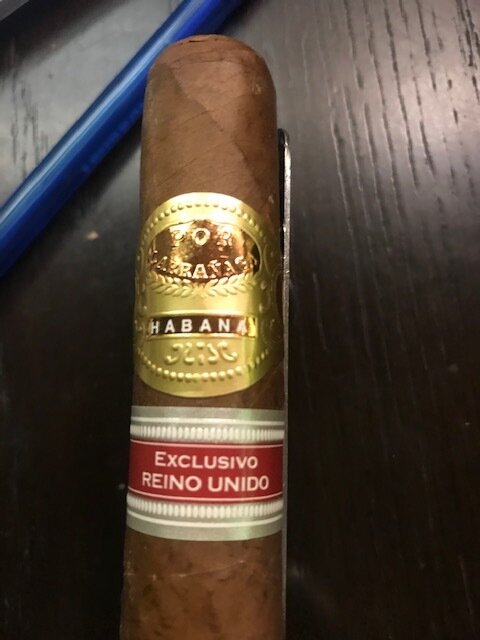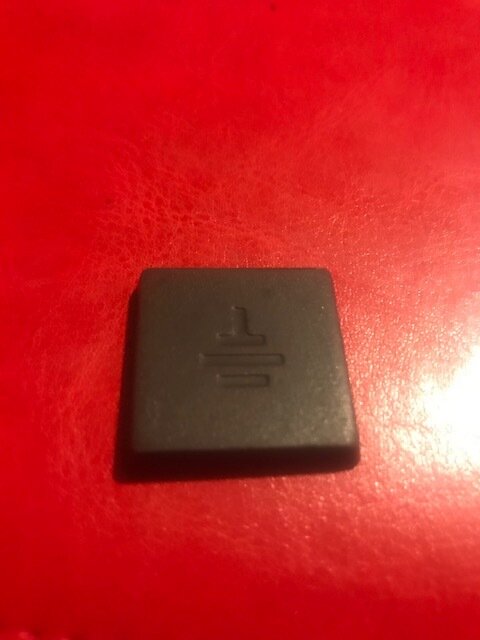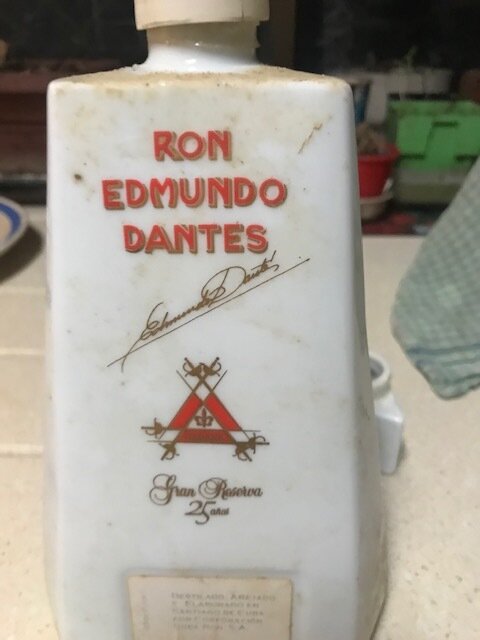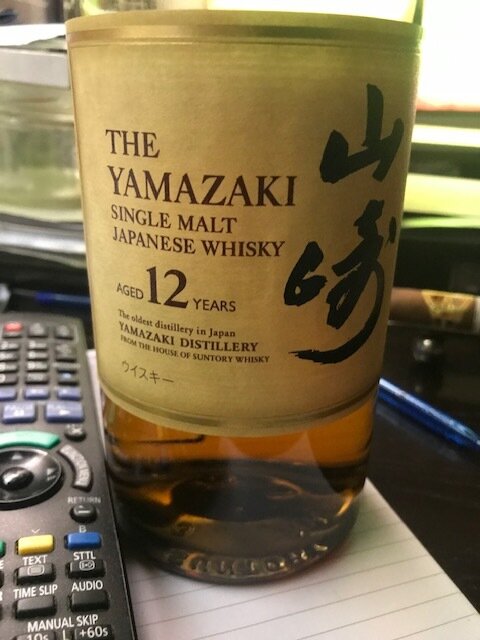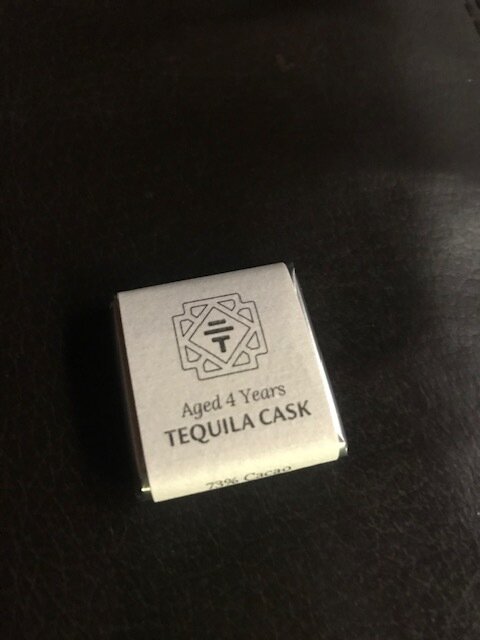Por Larranaga RR Reino Unido UK ‘Regalias de Londres’ 2010 – Montecristo Edmund Dantes 25-Year-Old Rum - Yamazaki 12-Year-Old Malt Whisky - To’ak Tequila Cask (4 Years) Ecuadorean Chocolate.
Forgive this break in the scheduled programming. I still have several of the Corona Gorda series to go but as many will know, our Lord and Master posted a thread about a few cigars he knew nothing about. Turned out, thanks to the amazing generosity of our good friend, Alex, I had one in the home humidor. So Presidential decree meant it was to be withdrawn and smoked. I serve at the pleasure… (and also because he promised me something exciting in its replacement, although I would most happily have done so without the mercenary element to this).
I thought, as we have descended into bitter winter (yes, all relevant) and I finally got the full set of Game of Thrones DVDs so Winter really is coming, I should binge and match it with some of the good stuff.
Cigar first. I need to confess that I have seen Cigaraholic’s review and I was astounded as to how closely it matched my own thoughts. Like we cloned reviews. Great condition. Dark, oily, slightly veiny. I did try and see what I could get before I lit the thing but it was too cold. My draw was quite tight, a bit too much so. I did try and fix it, which worked to an extent, but not as much as would have benefited the cigar.
Kicked off with honey and caramel. Then a woody earthy note. There was some citrus which mixed with the caramel but overall, the caramel was key. Some coffee grinds. There was some dark berry and spice, notably pepper, but most of all the PL caramel. A medium-bodied cigar that was more subtle than full-flavoured. This is a cigar which has yet to reach its best, even after a decade, and one which will go on for a very long time. For me, 93.
The matches. And what a good collection there were.
Kicked off with the last of my bottle of Montecristo Edmund Dantes 25-Year-Old Rum in its porcelain triangular bottle. This was very kindly sourced for me by our very good mate, Hamlet, quite a long time ago, and what a rum it has proven to be. One of the greats. Really complex and obviously mature, there were nuts, honey and also caramel – so you can see why it was ideal for this smoke. The use of seriously old material was immediately evident. A dense, seductive texture. This is a great rum but the absolute highlight was the length. Incredible. I cannot recall a spirit which had that length. I'd give the rum 98 and the combination, 100.
As a back-up, the Yamazaki 12-Year-Old Malt Whisky, which is a pretty terrific whisky. Complex, nutty, nougat, a hint of spruce or pine, a little chocolate note and plenty of hazelnut, orange rind and cinnamon. Any other time, this would have been a highlight. And while it was a fine match with the Por Larranaga, it was up against some pretty stiff competition.
Finally, from way out left field, I have been thinking about the recent post about cigars and food. For me, as I have said, I can handle it if we are in Havana with a bunch of mates, enjoying ourselves. Plenty of rum and basic food. But for anything half-serious, it is a no for me. Never eat and smoke at home. I reckon it stuffs both.
However, I thought I might try a piece of chocolate and the cigar. I had been doing an article on the To’ak chocolate from Ecuador (for Quill and Pad and I am pinching stuff from there for this). This is serious chocolate with an ultra-serious price tag. The 50-gram bars are around $400. I am not making that up. They also have little three-gram pieces (all beautifully wrapped and presented, as is everything these guys do) of their various chocolates which provide a good way to taste and experience these chocolates. Which you must do.
I chose the To’ak Tequila Cask (4 Years) Ecuadorean Chocolate. I'm still going with a no, for matching any food and a cigar, but this was not half bad. The complexity and richness of the chocolate stood up to the cigar, but it is a bit like when you are invited to a lunch by a mate. You get there and he is late but there are others turning up whom you vaguely know but have never really clicked with. And they are the only others present for the moment. All a bit awkward, even though it usually works out in the end. So it was with these unlikely bedfellows.
To’ak, which comes from the words for earth and tree from an ancient Ecuadorean dialect, has a great story.
The great Dave Barry once said, “Your hand and your mouth agreed many years ago that, as far as chocolate is concerned, there is no need to involve your brain.” Here we have a chocolate that is both sensual and cerebral. Whether To’ak is the best chocolate in the world will be up to each individual, but it is most definitely a strong contender.
When Christopher Columbus first encountered chocolate in 1502, it made little impact on him. He had no idea that it could be consumed and he may have only had a vague idea it could be used as currency. Chocolate reached Europe via the Spanish conquest, but was still very bitter, thanks to the manner it was made. Honey and spices were often added to make it more palatable. Over the years, the process of production was refined – salts to reduce bitterness, cacao butter removed to ease production, machine presses, the addition of powdered milk and more.
The location where the cacao trees which produce the best chocolate are grown is also a matter for endless debate. The majority of chocolate comes from West Africa. Around 5% of the world’s best chocolate is labelled as “Fine Aroma”. Ecuador produces some 60% of that 5%.
First, however, you start with the cacao tree. Some producers grow and harvest their own; others do not have that luxury and need to source fruit, often from a very long way away. Jerry Toth of To’ak compares the care of the cacao trees as akin to viticulture in Burgundy – there are few more sacred tasks.
The To’ak preference is for the Nacional Cocoa tree, once thought to be extinct. These days, many Nacional trees have been interbred, so care with selection is necessary. There is evidence of the Nacional as far back as 5,300 years ago. Long considered the superior tree, in 1916, this variety was devastated by an outbreak of ‘witches’ broom disease’ and also ‘frosty pod disease’ (say whatever you will about South Americans, but they know how to name a disease).
In 2009, the INIAP (Ecuador’s agricultural research institute) tested DNA samples from 11,000 cacao trees. Only six of them were found to be pure Nacional, but at least it was confirmation that the Nacional was not extinct.
A few years later, in 2013, To’ak found a grove of another 16 suspected Nacional cacao trees, between 100 and 120 years of age. This was in the valley of Piedra de Plata, which is located in the mountains of the Arriba region. DNA proved nine of these to be pure. Fifteen trees might not be enough on which to base an industry but it is a start. To’ak has worked closely with the authorities and is involved with the conservation of these trees.
The name ‘Arriba’ also has a nice story behind it. A few centuries ago, a Swiss chocolatier was looking to source supplies and met some local porters on the Guayas River. When the porters opened their bags, a wonderful floral aroma emerged. The chocolatier was enamoured and asked where these beans had been sourced. The natives replied, ‘arriba’, pointing back up the river – effectively meaning ‘upriver’. The chocolatier misunderstood, believing that Arriba was the region. And hence, it became so.
To digress, the cacao tree has a peculiarity about it. It grows flowers, and subsequently seed pods/fruit, on its trunk as well as its branches (such trees are known as cauliflory). Conventional wisdom insists that the pods from the trunk are not best used for seeds as they will, in turn, lead to lower-yielding trees, but they are fine for chocolate.
We are not so much interested in farming cacao trees, but the chocolate they produce. So, remove those seeds, pulp and all, and ferment, dry, roast, grind, refine and make chocolate (sounds simple).
The fermentation process – the contents of the pods are scraped out and exposed to the sun to ferment – helps break down the sugars. The beans are then dried, losing 50% of their weight. Most trees are lucky to give up a kilo of dried beans (I'm staggered by that). After roasting, winnowing removes the shells and the remaining nibs are reduced to paste by grinding. Cacao butter is released from the nib thanks to the levels of heat. Cooled and hardened, we have unsweetened chocolate. Refining is followed by conching, where the cacao butter is distributed within the chocolate. The heat releases flavours. It was this which enabled chocolate to move from just a drink to production as bars. This is, of course, an embarrassingly simplistic description.
At To’ak, after the grinding has produced a 100% pure cacao mass, solid at room temperature, a specialised grinder then “pulverizes the pure cacao mass into powder”. Then they simply put it in the bag.
To’ak began in 2007 when Jerry Toth, rainforest conservationist and cacao farmer, joined forces with his partners to take chocolate to a new level. The Bamboo House, where production was to take place, did not even have electricity when they began, so everything was done by hand. The cacao beans were roasted in an iron pot over a wood fire and then de-husked by hand, one by one. An old hand grinder was used to manually grind the beans. Jerry’s view of his work – “ People have had less noble aims.
Innovation has been key at To’ak and they have taken chocolate to places never envisaged. The contribution of barrels and casks to wine and great spirits, like whiskies and rums, is well known. To’ak has adopted that with their chocolate and developed the world’s first long-term chocolate ageing program, with the casks contributing to the flavours and aroma over time. The casks used range through Cognac, Whisky, Bourbon, Sherry, Tequila, Port and Sauternes. They also age their chocolate with items such as Kampot pepper and Palo Santo (an aromatic wood believed to have healing properties). They have also brought in the concept of vintage chocolate, which they combine with the location. So you can try chocolate from a specific region and identified year. Not really what you expect from a block picked up at the local servo. They are also very proactive in promoting the consumption of chocolate in combination with wine, spirits and even cheese (this was what inspired me to try the cigar). And like many of the world’s great wines, many of their editions are made in tiny quantities, sometimes as little as 150 bars for the entire ‘edition’. Some even less.
Ageing chocolate is a concept that To’ak has also embraced, pioneering the process in 2013. Just as barrels contribute to certain spirits and wines, so too can they influence chocolate. Some of the flavours they have noted include vanilla, florals, spices, buttery notes, coconut, malt, nuts and caramel. The chocolate is usually placed in the barrels in solid form but either way, the high percentage of fat in chocolate, often referred to as cacao butter, allows the oak to impart these flavours. To’ak neither extracts the cacao butter from the chocolate, nor does it add any, but as noted, it has properties which allow it to absorb flavours during this process. This is why an open bar of chocolate in the fridge or elsewhere might quickly pick up the flavours of whatever is nearest, which can be an issue.
To’ak has aged chocolate for up to four or five years so far. They are still learning about these processes. Cognac casks, for one, will impart sufficient flavours within a year. Other substances take much longer.
So how good is this chocolate? Is it worth the extraordinary prices asked? To the former, seriously wonderful. To the latter, a decision for every individual, but trying To’ak should surely be on every bucket list. Just accept that you will be paying hundreds of dollars for small bars of chocolate. We would never quibble about this for a glass of DRC or an equivalent amount of caviar. The problem is recalibrating our perception of what we should pay for great chocolate. Check them on www.toakchoclate.com.
Some of their chocolate –
3 Years Islay Casks –
I will confess that, while I enjoy a wide range of whiskies, those peated beauties from the Scottish island of Islay are particular favourites. This chocolate spent three years maturing in a cask sent to To’ak from Laphroaig, one of the greatest of all Islay distilleries. The result will change your perception of chocolate forever. Don’t look for a chocolate soaked in whisky and dominated by it. Rather, this is far more subtle. There are some peat notes with honey and caramel, and hints of sea breeze, even perhaps oyster shell. This is chocolate, but not as you know it. Add in some smoke and cassis. This is manna from heaven, or perhaps chocolate from angels.
3 Years Sauternes Cask –
What is so evident with these chocolates is the incredible intensity of flavour, but also how they are so amazingly well balanced. Never intrusive or jarring, no matter how powerful. And they last for a length of time that one could never envisage. Here we have stonefruit, a rancio note like a good fortified, spices, honey, nectarines and apricots, a hint of cassis. Glorious.
5 Years Andean Alder –
To’ak aged their original Andean Alder chocolate from 2014 for four years. Has any chocolate ever been aged for that period? This release saw an extra year. The alder is a tree which is related to the birch family. Its wood has been used to smoke seafood and coffee and even used in the manufacture of electric guitars. It forms the basis of the foundations of Venice.
Its use in the manufacture of chocolate provides for something rather unexpected. There is a maturity and sophistication here. Tobacco leaves, cedar, red fruits, spices, a hint of barbecued lamb, strong espresso, plums. A slight bitter almond note on the finish (this is 81% – To’ak does not make an issue of percentages, but for the record, they range from low 70s to low 80's, but remember, this is not strictly an indicator of quality but rather of bitterness. The higher the percentage, the more bitter the finished chocolate), perhaps more so than with most of the To’ak chocolates. There is even some grip. I can imagine coming in after an evening of winter fishing and relishing this chocolate. This is not your pretty sweetie. Cerebral chocolate, if ever there was one. Love it. I know they make a chocolate which has spent considerable time in Islay casks but if I wanted to match this with anything, Laphroaig or Ardbeg do spring to mind.
Rain Harvest 2017 –
The concept of vintage chocolate is something with which the world will have to come to grips. Bringing this chocolate closer to the concept of fine wine, the trees see no irrigation, so conditions will offer a strong influence. It would be a little pointless for me to attempt to identify what each vintage offers. Rather, simply enjoy the chocolate for what it offers. Here, a delightful nuttiness pervades. There is a subtle and gentle nature to this chocolate. A refreshing style, some red fruits, raspberries, even blackberries, make an appearance. Some nougat, dark coffee and cranberries as well.
4 Years Tequila Cask –
This is the one I paired with the cigar. Just as Don Julio Gonzalez revolutionised the tequila industry, so too have the team at To’ak changed the world of chocolate. It doesn’t hurt that the team at To’ak enjoy pairing their chocolate with Don Julio’s tequilas. The collaboration extended to Don Julio sending three casks for To’ak to use for ageing. They experimented, a Light in one (73%) and a Dark (80.5%) in another (nibs, less successfully, in the third). Light picked up the flavours in a more concentrated manner. The result here was like a velvet crunch. Honeysuckle and caramel notes, while retaining freshness.
KBG


